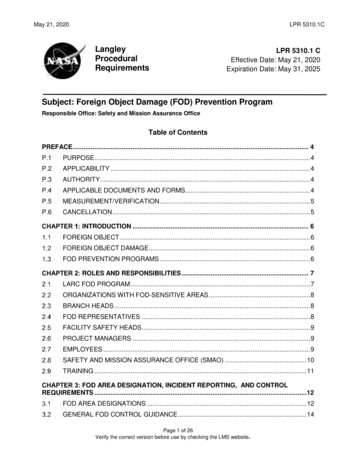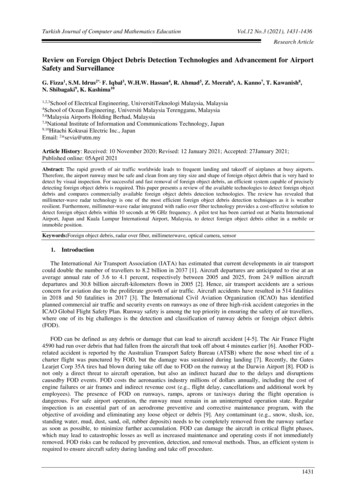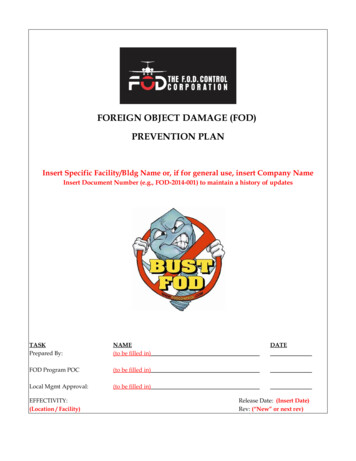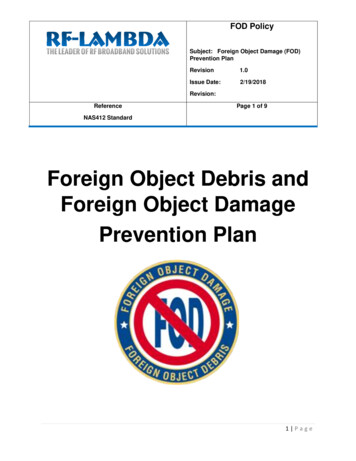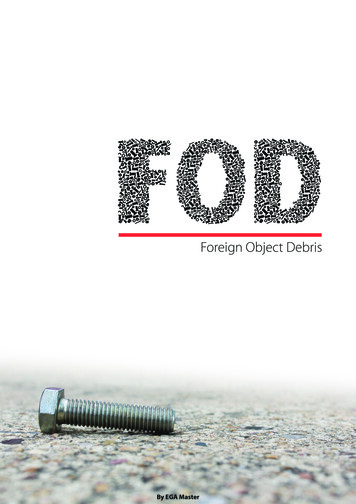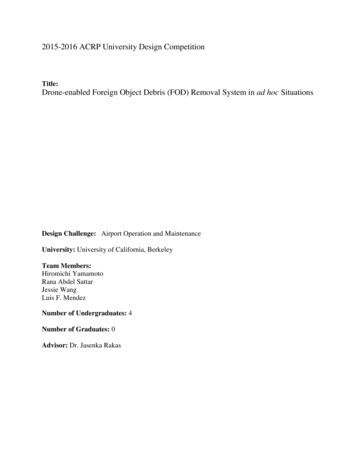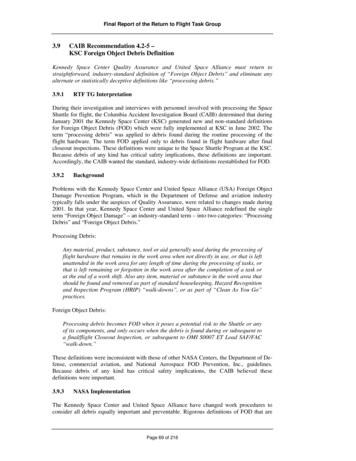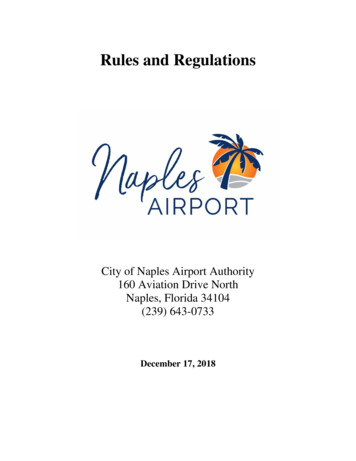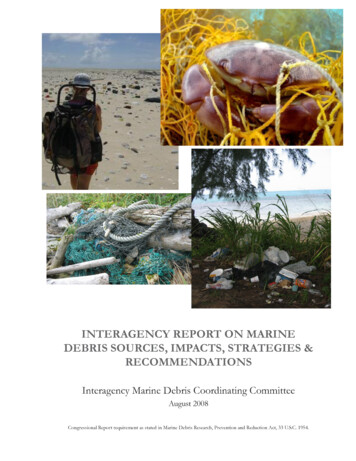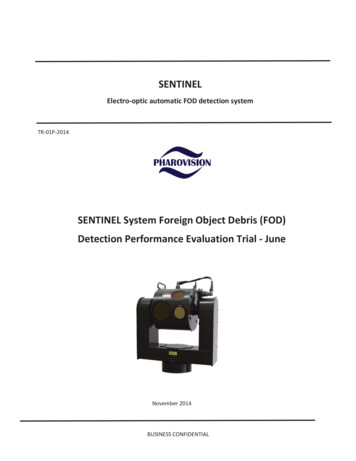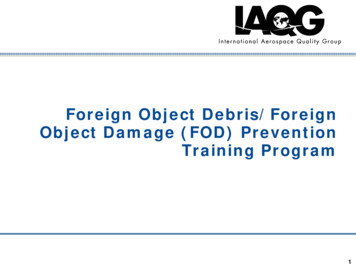
Transcription
Foreign Object Debris/ForeignObject Damage (FOD) PreventionTraining ProgramCompany Confidential1
FOD Training Program Objective The primary objectives of a FOD preventiontraining program is to increase employeeawareness to the causes and effects of FOD,promote active involvement through specificprocesses & prevention techniques, andstress good work habits through workdisciplines.2
What is FOD?Foreign Object Debris (FOD)A substance, debris, or article alien to thecomponent, assembly, system or vehicle that couldcause damage.Foreign Object Damage (FOD)Any damage or incident attributed to a foreignobject that can be expressed in physical oreconomic terms that may or may not degrade theproduct’s required safety and/or performancecharacteristics.
FOD Training Program Topics Proper storage, shipping and handling of material,components, and equipment Techniques to control debris Housekeeping Cleaning and inspection of components and assemblies Accountability/control of tools and hardware Control of personal items, equipment and consumables Care and protection of end items Quality workmanship (“Clean-As-You-Go,” Inspection) How to report FOD incidents or potential incidents
Examples of FOD One should always be aware of and on the look out forFOD or Potential FOD, here are some examples ofrecognized FODa.Unorganized workplaceb.Unaccounted for tools or tool detailsc. Scattered components on work benchd.Metal chips not cleaned up in the work placee.Food at workspacef. Protective covers not installed or improperly installed
Outcomes of FOD FOD can cause delays in manufacturing andassembly FOD can cause product failure FOD can cause loss of business FOD can cause injury and deathFOD comes in all shapes & sizes .
Failures Caused by FOD FOD may cause many failures and damages, but worst ofall – it might cause injuries and even loss of human life! FOD can also cause damage to the company’s financesand reputation. It is a fact that foreign objects and/or debris havecontributed to jammed flight controls, engine damage,electrical shorts, fluid contamination, control valvefailures, fires and other major failure incidents that haveresulted in costly material damage, loss of vehicle and oflife. Foreign material comes in many shapes and forms. Itmay present itself as a hand tool, dust, grime, oil, metalshavings, loose nuts, bolts, cotter pins, lock wireremnants, pencil, pen, packing material, etc.
ExamplesTypical FOD
ExamplesSmall, seemingly insignificant itemscan lead to Big Problems
ExamplesManufacturing Process Debris:Polishing Material-FODThis pump wasreturned by acustomer becauseof a foreign object.Scotch bright
ExamplesAssembly Process Debris:Fabric In Sealed Assembly-FOD Product leaked during acceptance testingLeak was caused by a nylon fiber contaminant preventingseal integrity at a manifold interfaceThe nylon fiber came from clothing or a lab coat
ExamplesAssembly Process Debris:Fasteners-FODThis pump blew afteringesting several screwsat the customer. SmallFOD can cause bigproblems.
ExamplesFood In The Workplace:Food-FODOatmeal on aTurbine Blade!!
ExamplesFood In The Workplace:General Housekeeping (6 S)-FOD
What is 6-S?Every Thing has a Place and Every Place has a Thing! Sort – Discard everything that you don’t useShine – Clean!Straighten – Label & organize in a way to promote work flowStandardize – Assign rolls and responsibilities, standardizeprocessesSustain – Audit on a set frequency to make sure the 6Sprogram is being maintainedSafety – Keep the work area safe and walk ways clearWe can layout our areas so they flow better and areeasier to clean and maintain.
ExamplesTool Control:Tool Details-FODLeverAfter repeated use, the screwbacks out of flex socket
Proper storage, shipping and handling ofmaterial, components, and equipment. Handle and store parts, assemblies, fixtures, andequipment in a manner that prevents damage,deterioration, or contamination. Be aware of any special handling considerations, thismay include hazardous material requirements asapplicable. Properly store equipment and tooling in designatedareas Use protective caps and material as specified. Be aware of any ESD requirements the product may beeffected by.
ExamplesPART PROTECTION & MATERIAL HANDLING Packaging & Shipping our product creates an opportunityfor objects to invade them. By adding a FOD check along with a quality inspection, wecan push FOD problems back to their sources. This willeventually make our jobs easier. Upon Receiving and Prior to Shipping Material Inspect for:» Proper part number» Proper packaging» Damage» Cleanliness» Foreign Object Debris/Damage Report any Non-Compliance per Procedure.
ExamplesManufacturing Process Debris:Machining Chips-FODMachiningChips
ExamplesManufacturing Process Debris:Tumbling Media-FODTumbling Media
Methods For Preventing FODKey Attributes of Robust FOD Prevention FOD Awareness and Training – Promote participation inFOD elimination and provide frequent training. Material and Part Handling – Move and store all parts andproduction tooling in a way that prevents all damage andcorrosion. General Housekeeping and 6-S – Implement goodcleaning practices as well as organization of parts, tools, andsupplies. FOD Reporting – Know who to contact and what to do in anactual, or suspected, FOD event
Methods For Preventing FODKey Attributes of Robust FOD Prevention FOD Management – Assign a person or people to be theFOD focal point Processes – Use prevention, detection, and cleaning toeliminate process media and debris Tool Accountability – Know where your tools are and thecondition they are in. Measuring Performance/Metrics – Track FOD incidentsand finding, use Root Cause and Corrective Actions to makeimprovements
Methods For Preventing FODKey Attributes of Robust FOD Prevention Communication and Feedback – Put up Posters or FODAlerts in common areas so that all personnel are aware ofFOD Risks Consumable Control – Keep Consumables out of FODcritical area and use on a “take as needed” basis Hardware Accountability – Know what you have usedand how much you should have left Personnel Control – Identify FOD Control Areas, allowingonly the required personnel and tools access
Simple Rules To Help Prevent FOD Establish processes to prevent, detect, andclean debris at proper intervals. House keeping (Clean as you go) Keep yourwork area clean and organized. Maintain tool awareness, organize tools sothey are easily accounted for, do so before andafter your work assignment. Secure loose tools with appropriate equipmentor methods. Account for all material and equipment used inthe process, (e.g. shadow boxes, cut-outs, anddesignated storage locations for tooling andequipment).
Simple Rules To Help Prevent FOD Verify that your clothing and accessories (e.g.pens, staples, strings) do not contaminate orprovide an avenue for contamination. Handle and store parts, assemblies, fixtures,and equipment in a manner that preventsdamage, deterioration, or contamination. Inform your Supervisor or Team Leader of anycondition that may lead to a potential FODinduced failure or incident. Ensure that all assembly layouts are free fromforeign objects prior to layout inspection.
Simple Rules To Help Prevent FOD Ensure that each component or pre-assembly isthoroughly clean. Ensure that all sub-assemblies ready for finalbuild-up are properly protected to prevent FOD. Ensure workbenches are faced with a hardwearing material. Prevent visible particles from entering theimmediate work bench area of assembly.
Simple Rules To Help Prevent FOD Utilize cleaning cloths that are non-sheddingfiber in nature. Post FOD alert prevention signs in designatedareas.
Lost Item ProgramAny time an item is lost during an assembly,manufacturing, or maintenance task, ceaseactivity in the affected area and initiate asearch for the item.Continue this search until the item is found oradequate program results are achieved andproperly documented according to the lostitem procedure.
PEOPLE IN THE PROCESSFOD elimination should be a focus at ALL stepsFrom initial designto shipment, thereare manyopportunities forforeign objects toinvade theproduct.Preventing FODat only one stepis not sufficient.DesignMachiningOverhaul& RepairAssemblyShipping &ReceivingPackagingTesting &Inspecting
Responsibility for FOD It is EVERYONE’S responsibility torecognize and prevent FOD Don’t rely on the person who lookedbefore you .or the person who will look after you
RESOURCESThere are a lot of publically accessibleorganizations who focus on FODelimination, for more information: The F.O.D Control Corporation FODNews.com National Aerospace FOD Prevention, Inc. NAFPI Insight SRI –FOD Papers National Center for Aerospace & TransportationTechnologies
Questions?
Foreign Object Damage (FOD) Any damage or incident attributed to a foreign object that can be expressed in physical or economic terms that may or may not degrade the product's required safety and/or performance characteristics. Foreign Object Debris (FOD) A substance, debris, or article alien to the component, assembly, system or vehicle that .
